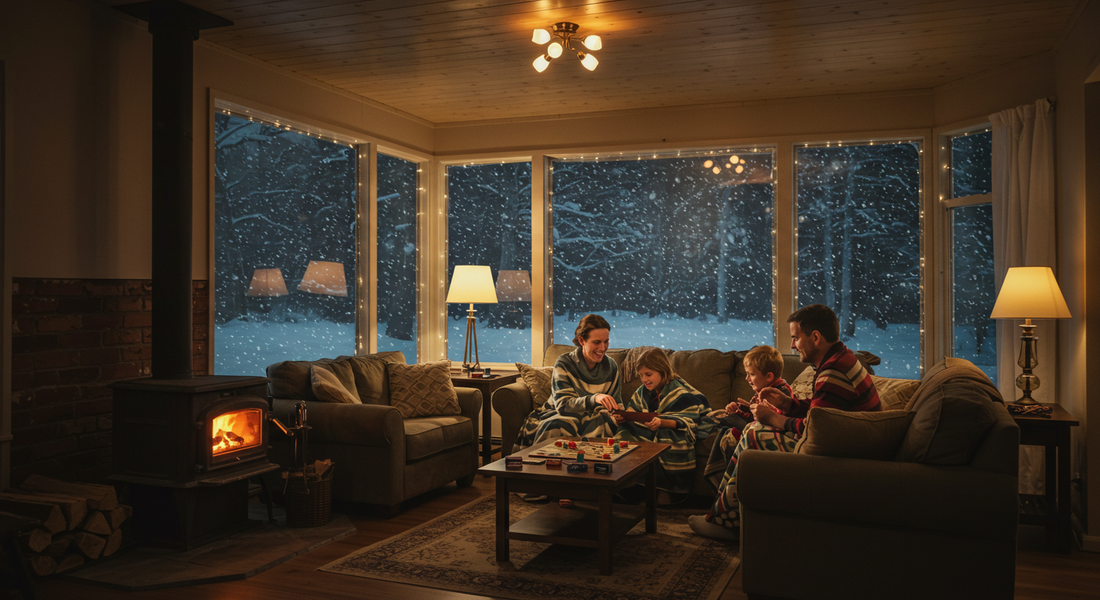
Winter Storm Preparedness: How to Survive Being Snowed In
Share

A severe winter storm is more than just a picturesque snowfall; it's a unique and dangerous emergency that can lead to power outages, impassable roads, and prolonged isolation. Winter storm preparedness is about recognizing these dangers and taking proactive steps to ensure your family's core priorities are met: staying warm, having enough food and water, and maintaining your safety. When a blizzard is in the forecast, your home is your shelter, and a good plan is your best defense against the cold.
Preparing Your Home
Your house is your first and most important line of defense against a winter storm.
-
Insulate Windows and Doors: A significant amount of heat is lost through cracks and gaps. Use weather stripping or caulk to seal any leaks around doors and windows. For an extra layer of insulation, you can use a window insulator kit, which uses a sheet of plastic film and a hairdryer to create an insulating pocket of air.
-
Safe Use of Alternative Heating: If the power goes out, you'll need a backup plan for home heating emergency.
-
Propane/Kerosene Heaters: These must be rated for indoor use and require proper ventilation to prevent deadly carbon monoxide buildup. Never leave them unattended, and keep a window cracked for fresh air.
-
Wood Stoves/Fireplaces: Have your chimney professionally cleaned and inspected annually. Ensure you have a good supply of dry, seasoned firewood.
-
-
Prevent Frozen Pipes: Let your faucets drip slightly to keep water moving through the pipes. Open cabinet doors under sinks to allow the warmer air of the room to circulate around the plumbing. Know where your main water shut-off is in case a pipe does burst.
Preparing Your Vehicle
A winter storm can be especially dangerous if you are on the road. A dedicated winter emergency car kit is essential.
-
Build Your Car Kit: This kit should live in your car all winter long. It should include:
-
Extra blankets, hats, and gloves
-
A snow shovel and ice scraper
-
A bag of sand or cat litter for traction
-
Jumper cables
-
A flashlight with extra batteries
-
A power bank for your phone
-
High-energy snacks and water
-
-
If You Are Stranded: Stay in your vehicle. It is your best shelter. Run the engine and heater for about 10 minutes every hour to stay warm, and make sure the exhaust pipe is clear of snow to prevent carbon monoxide poisoning. Tie a brightly colored cloth to your antenna to make you visible to rescuers.
Essential Winter Supplies
In addition to your standard emergency supplies, a winter storm requires a few specific items.
-
High-Calorie, Easy-to-Heat Food: Stock up on food that requires minimal cooking, like canned soups, chili, and pasta. Hot drinks like cocoa, tea, and instant coffee are also great for boosting morale and core body temperature.
-
Ice/Snow Removal Tools: Have rock salt or a pet-safe ice melt on hand to treat walkways and steps. Ensure you have sturdy, ergonomic snow shovels ready to go.
-
Warmth and Light: Have a supply of extra blankets and warm, layered clothing for everyone in the family. Stock up on flashlights, lanterns, and plenty of extra batteries.
Conclusion: Your 72-Hour Storm Checklist
As a major storm approaches, use this final checklist in the 72 hours leading up to its arrival:
-
72 Hours Out: Stock up on all necessary food, water, and supplies.
-
48 Hours Out: Fully charge all your electronic devices, including power banks. Ensure your car has a full tank of gas.
-
24 Hours Out: Bring patio furniture or anything that could be blown around inside. Check on elderly neighbors to ensure they are also prepared.
Proper winter storm preparedness is about taking the threat seriously and acting ahead of time. By preparing your home, vehicle, and supplies, you can stay safe and comfortable until the storm passes.
